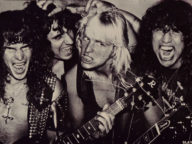The Keystone
The Keystone Berkeley, which hosted performances between 1972 and 1984 at 2119 University Avenue, was a nightclub where experimentation was the order of the day, and musicians and music lovers alike could come together to experience music for music’s sake.
In the early 1970s, rock music—which had been central to the counterculture of the ’60s—was becoming an ever-more massive business. Concert promoters like Bill Graham were scaling up, putting on giant shows held in baseball and football stadiums. Acts that formerly had played exploratory spaces like the Fillmore—bands like The Grateful Dead and Crosby, Stills, Nash and Young—were now playing to crowds of over 40,000 in arenas like the Oakland Coliseum, which hosted Graham’s “Day on the Green.”
The Keystone Berkeley, along with other Bay Area nightclubs, became a haven for music lovers who felt detached from the music in the large stadium settings. The Keystone Berkeley did not discriminate musically: it was where Jerry Garcia was free to play funk and bluegrass, and also where some of the first glimpses of thrash metal surfaced, its stage playing host to future legends Metallica and Slayer. Many local bands were given an opportunity to shine as well. Quirky punk band Psycotic Pineapple and soulful acts like Grayson St. had a home at the Keystone Berkeley. Clubs like the Keystone Berkeley allowed the Bay Area’s legacy of creative art and music to live on. These clubs were incubators for what was next.
Jerry Garcia’s Home Away From Home
By the early 1970s, the Grateful Dead had become a musical juggernaut; they were playing their biggest shows at places like the Long Beach Arena in 1972 and the Boston Garden in 1973. Jerry Garcia, though, was always excited about playing live for smaller audiences and found a home at the Keystone Berkeley to express that love; his passion outweighed the growing concert business’s restrictions in the 1970s. His many side projects—Old and in the Way, Legion of Mary, The Great American String Band, and Jerry and Merl—played the club month after month during the lifetime of the club.
In their own way, each of these bands showcased Garcia’s different musical interests. The Bill Monroe-influenced bluegrass band Old and in the Way played the Keystone numerous times. Garcia, on banjo, didn’t have to live up to the fan expectations that were growing in the mid-’70s. The band, including Vassar Clements, David Grisman, Jerry Garcia, and Peter Rowan, played a mix of traditional bluegrass songs, originals, and re-arranged covers.
Legion of Mary, and the work Jerry and Merl Saunders played, was more of hybrid of jazz, rock , reggae, and funk. Their unmistakable sound–weaving Garcia’s unique guitar playing with Saunders soulful organ work–filled the little club in Berkeley. Merl and Jerry would work together under the Legion of Mary name but also as Jerry and Merl. By and large, they played cover songs from a wide array of genres. Jimmy Cliff’s “The Harder They Come” could be heard in the same set as an up-tempo, scorching version of “That’s Alright Mama,” the song made famous by Elvis Presley.
Jerry Garcia played the Keystone Berkeley over 200 times—not because he needed the gigs but because he loved playing music there. Able to try out new ideas at the Keystone, he expanded the scope of what he could do as a musician—and passed onto future musicians a model of curiosity-driven freedom and experiment.
The Eclectic Sound of the Keystone Berkeley
Jerry Garcia had to share the Keystone Berkeley with a multitude of national and local acts that kept the hungry, passionate live music fan excited about the Bay Area. Herbie Hancock, Ray Charles, The Talking Heads, The Ramones, Eddie Money, The Dead Kennedys, Third World, and B.B King are just a small sample of the musicians who graced the Keystone stage during the 1970s. Many found playing in the Bay Area to be a special experience. They knew the audiences in these smaller venues were receptive and open-minded; expectations could be checked at the door.
The Keystone Berkeley was also a place where local acts could find exposure. Club owner Freddie Herrara (though not immune to controversy) was supportive of local music and wanted the club to be an incubator for the Bay Area music scene. R’n’B band Grayson St. played the club often. Beserkeley Records artists Greg Kihn, Earth Quake, and The Rubinoos shared their unique and catchy rock.
The punk scene had an early home in the East Bay at the Keystone. Before Gilman or Berkeley Square, pioneering punk bands The Nuns, Flipper and the Dead Kennedys performed at the Keystone.
The Keystone’s performers truly ran the pop-music gamut. Reggae royalty Hugh Mundell and Third World provided Berkeley audiences with the special music of Jamaica. Thrash titans Exodus, Megadeth, Slayer, and Metallica cut their teeth at the Keystone Berkeley before rowdy crowds made punk and metal less welcome in the club. (They found a home at Ruthie’s Inn.)
Though physically gone, the Keystone Berkeley created a considerable musical legacy. Its spirit lives on in venues such as San Francisco’s Slim’s and Oakland’s Metro — clubs that are willing to take risks, support alternative nationally touring acts, and spawn new local sounds.
— Matt Willett

Drummer Joey Covington with the Rocky Sullivan band at the Keystone (courtesy of Ed Perlstein)



























